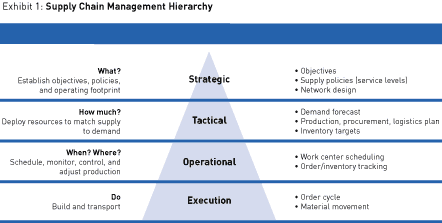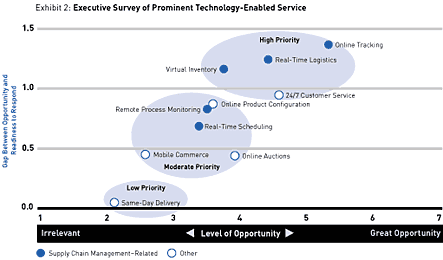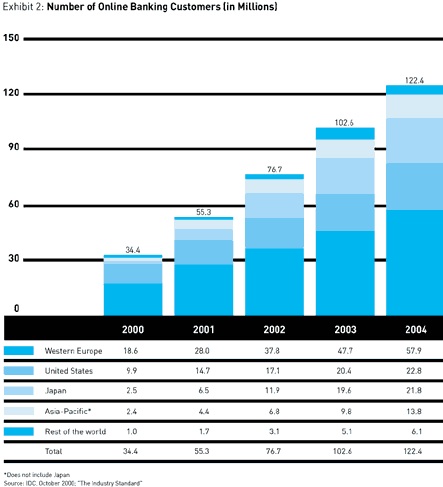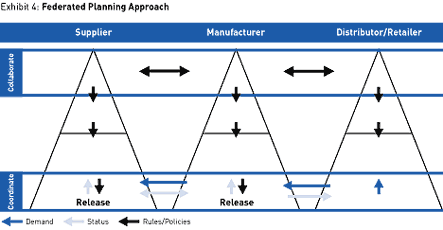Beyond Utopia: The Realist’s Guide to Internet-Enabled Supply Chain Management
The solution to more efficient supply networks lies not with “frictionless” technologies, but with shared objectives and insights across the extended enterprise. Call it “Federated Planning.”
 |
|
Sam Wacksman |
The central planning concept clearly failed in its most radical form, the economies of the former Eastern Bloc. Yet today, core elements of the central planner’s Utopian dream live on in academic papers, in the business press, and in the sales brochures of uncounted software and technology vendors. Nowhere is this fantasy more evident than in supply chain management. Armed with more real-time data, a better algorithm, more connectivity, and a bigger IT budget, managers (or their computers), the dreamers believe, could control their extended enterprise free of market imperfection.
The Internet seems to be on the verge of turning such wishes into reality. Wireless technologies make it easier than ever to monitor inventories and equipment remotely and to track orders and trucks in real time. Web-enabled tools allow companies to view operational details of the partners in their supply network and to track demand at point-of-sale. Emerging tools are beginning to offer promises of seamlessly linked supply chains that — fueled by real-time data — will coordinate and ultimately optimize supply chain networks across the extended enterprise. The term extended enterprise resource planning (eERP) has begun to appear in the press to describe this phenomenon.
We believe that attempts to create the Utopian planned supply chain will ultimately fail. Although we have no doubt there is true value to be gleaned from emerging capabilities, we also believe there is risk in becoming too enamored of their potential. We hold a more sober (but, in our opinion, more realistic) view of how companies can leverage emerging technologies to move toward the goal of achieving more effective supply chains. The key lies not in gaining more visibility or computational power, but in enabling supply chain partners to align business objectives and reengineer the supply chain across the extended enterprise. We call this approach Federated Planning.Supply Chain Management: The Evolution
Supply chain management has changed little since Booz-Allen & Hamilton introduced the term in 1982. Historically, functions — from procurement through manufacturing, distribution, sales, and marketing — “owned” parts of the supply chain. Conflicting objectives and distortions between and among them led to delays, excess capacity, and excess inventory throughout the supply chain. Booz-Allen’s supply chain management approach called for an overarching supply chain strategy and control architecture to align functional activities with business objectives. (See Exhibit 1.)

Strategy determined how assets were deployed to meet service and cost objectives, driving manufacturing footprint, inventory, and production allocation decisions. Policies, rules, and procedures, which together make up what we call control architecture, managed assets to meet customers’ needs. This control architecture defined replenishment, planning, and scheduling processes and policies, and supported metrics, systems, and organizations. A control framework defined the hierarchy of supply chain management and processes that aligned functional activities at each level.
Over the years, supply chain management efforts seemingly were hampered by gaps in information: inaccurate demand statements, lack of visibility into current order and supply positions, and incomplete understanding of costs, capabilities, and constraints. Companies were forced to hold excess capacity and inventory as they second-guessed demand projections, delivery schedules, and capacity and material availability across the supply chain.
The Internet has promised to change all that. Web-enabled tools offer complete visibility and communication across the extended enterprise, delivering perfect information with the potential to eliminate waste throughout the supply chain. With that promise, supply chain management is moving to the forefront of business strategy in many industries — and capturing the attention of senior management. In a July 2000 survey conducted by Booz-Allen & Hamilton, Fortune 500 senior executives ranked tools such as real-time logistics planning, remote process monitoring, and online order tracking high in opportunity, but thought their companies did not have the capabilities in place to take advantage of them soon. (See Exhibit 2.)

This renewed interest in supply chain management is well founded. Expanding market reach, greater customer focus, and increasing market and cost pressures are forcing many companies to reevaluate the effectiveness of their supply chains. The increasing compression of concept-to-launch cycles and product life cycles is mandating more flexibility and agility in supply chains than they have ever had before. As many industries undergo difficult transitions, they are focusing more sharply on supply chain partners to improve supply chain capabilities and economics. Collaborative planning, or the cooperation by supply chain partners to achieve more accurate forecasts and plans, is now widely touted as the next revolution in supply chain management.
Not surprisingly, the consumer products industry has been at the forefront of the collaborative planning movement. However, even after a decade of such initiatives as Efficient Consumer Response and Direct Store Delivery, the consumer products industry still carries, on average, 14 weeks of inventory, which represents $300 billion in goods trapped in the supply chain. Clearly, improved collaboration among supply chain partners is needed to further increase efficiency and reduce inventory.
In 1994, a coalition of consumer products manufacturers, retailers, software vendors, and IT consultants launched the Collaborative Planning, Forecasting, and Replenishment (CPFR) initiative to create a standard protocol for exchanging data between supply chain partners. Several pilot efforts have shown notable success among companies exchanging plan and forecast data. In one example, Nabisco Inc. and Wegmans Food Markets Inc., a U.S. grocery chain, improved category sales for Planters nuts by 13 percent — compared with an 8 percent drop in the market — and reduced inventory by 18 percent while improving the service level from 93 percent to 97 percent. Although such pilots demonstrate the benefit of sharing plan and forecast data, how CPFR will manage the complexity, and conflicting objectives and priorities, of multiple supply partners is unclear. As Jay Nearnberg of Warner-Lambert Company (now part of Pfizer), one of the pioneering CPFR companies, states, “CPFR seems to work with a single manufacturer collaborating with a single retailer. Whether it will have the same results when multiple manufacturers collaborate with the retailer for the same product [has] yet to be tested.”
Collaborative planning is looking to move beyond the periodic sharing of plan and forecast data through Web-enabled visibility tools. These tools will allow companies to share detailed data across the extended enterprise, accessing point-of-sale data at the stock keeping unit (SKU) level and status of orders and shipments in real time. Early successes promise huge potential. For example, Ford Motor Company and UPS Logistics, a wholly owned subsidiary of United Parcel Service Inc., launched an effort to reduce the time it takes vehicles to reach dealers from assembly plants — historically, two weeks. Through vehicle-level tracking that improved coordination among rail cars, trucks, and haul-away tractors, UPS has already reduced transit time for new Ford, Lincoln, and Mercury brands by four days since March 2000, saving $1 billion in vehicle inventory and more than $125 million in inventory-carrying cost.
Bring on the Vendors
With a promise so great, it seems only natural that visibility and collaboration tools should be linked, allowing management and optimization of the supply chain through the use of real-time data. A host of vendors are developing systems to collect such detailed, real-time data at each tier in the supply chain and to coordinate the flow of goods across the extended enterprise. Some are developing massive optimization algorithms that will evaluate and redefine supply structure in response to real-time data. Some envision systems that will seamlessly link supply chain partners through a common system, a conduit for all information flow and controls throughout the supply chain — a concept some are referring to as an eERP system. The system would synchronize activities across the supply chain to trigger machines and trucks into motion; reset production mix and volume; reallocate resources; and, when linked to Advanced Planning, Scheduling, and Network Optimization tools, optimize the integrated supply network. (See Exhibit 3.)

Proponents of eERP suggest that with a common understanding of the supply universe, participants would work toward a common goal of maximizing profit for the whole. Priorities and conflicts would be resolved objectively by an eERP system that worked to achieve optimum solutions across the extended enterprise. Participants would willingly share sales and production data to maintain the validity of the eERP system. Or, better yet, the system would be directly linked to data sources to ensure that real-time data flowed seamlessly across organizations.
The eERP movement seems to be well under way. Software vendor SAP AG is strengthening its supply chain management capabilities, having added Logistics Execution Systems in 1999, followed by Advanced Planning and Optimizer (APO), a tactical forecasting and network optimization tool. SAP is currently building collaborative planning capabilities into APO, and is positioning itself as a provider of integrated supply chain management solutions. Similarly, the Oracle Corporation recently added a logistics management module to its suite of tools that already included supply chain management. Companies such as i2 Technologies Inc. and Manugistics Group Inc. are becoming full-suite supply chain solution providers; B2B exchanges are positioning supply chain management as a core value offering; and niche technology vendors are scrambling to build relationships with established enterprise resource planning (ERP) and software companies and IT consultants.
The vendors’ rush to join the supply chain management bandwagon is understandable. Supply chain management software is projected to grow 47 percent over the next five years; at the same time, ERP growth rate will slow to an anemic 5 percent. Not only will supply chain management tools replicate the heady growth enjoyed by ERP in the late 1990s, but they also promise to employ the armies of IT programmers and consultants displaced by the slowed growth of ERP.
Despite the risk that eERP could bring with it the same ballooning cost and lock-in problems associated with ERP before the “e,” executives will find the lure of efficient supply chains difficult to resist. But when software companies come knocking to offer an extended ERP system — promising millions in savings and the mother of all supply chain management tools — companies should proceed with caution.
The idea that independent companies can be joined into a single entity with perfect real-time data and analysis brings us back to our analogy of the Utopian central planner. While the idea of a harmonious, unified supply network is comforting, we believe that this view is overly idealistic and that it severely underestimates tensions and complexities inherent in the supply network. Further, we believe the quest to build a highly responsive, efficient supply chain will create dependence on real-time data that will introduce unnecessary variability and instability into the supply chain, which could ultimately undermine participants’ strategic objectives.
First, the Utopian view fails to recognize the tension and conflict in the supply chain that result from competition for limited resources and distribution of profit and risk. In one telling example, the $45 billion U.S. apparel textile industry launched an effort in 1993 to develop an industry-wide collaborative decision support tool. Industry leaders hoped that understanding the impact of decisions would promote collaboration among the supply web partners, despite decades of competition and mistrust. After six years of work by industry specialists, the Department of Energy, and academics, the goals were not achieved; the project was recently handed off to CPFR. In our opinion, continuing down this path will quickly debilitate the collaborative planning efforts. This example helps prompt our more cynical view that, as conventionally envisioned, collaborative planning efforts will degenerate, with each company working to achieve its own objectives and motivated to withhold valuable information that could be applied to gain an advantageous position in the market, just as they have always done.
Furthermore, the Utopian, single-entity approach severely underestimates the enormity and complexity of the supply chain. In the apparel textile example, 30 synthetic fiber plants, 6,000 textile plants, 20,000 cut-and-sew plants, and 100,000 retail outlets make up a supply chain that conducts more than 20 billion consumer transactions each year. The industry’s supply chain is further influenced by the supply chain partnerships for other products within it, each competing for shared resources over the extended supply chain. The textile apparel supply chain, in short, is less a chain than a complex web of intersecting supply chains. Even from the perspective of one company, tens of thousands of nodes make up this supply web, with each node participating in up to hundreds of thousands of production activities each day. Layers of interconnected decisions make it impossible to get a comprehensive view of the supply web. And without understanding a participant’s entire set of customers, product lines, economics, capabilities, current practices, and culture, it is difficult to distinguish real supply constraints from those that are imposed by other decisions and assumptions.
Finally, emphasis on real-time data to manage the supply chain introduces unnecessary instability and may inadvertently lead companies away from their strategic intent. Powerful Internet-enabled technologies track point-of-purchase demand at the SKU or outlet level in real time or near–real time, with the possibility of a supply chain that can respond to orders as small as a single unit. However, driving the supply chain at the single-unit demand level introduces unnecessary variability, particularly in industries with unpredictable demand patterns. Without adequate restraints, the optimization model may react to data points, rather than trends, and create wide fluctuations in production planning.
Similarly, eERP systems may respond inappropriately to real-time capacity and supply positions, creating an availability-driven model in which production mix and volume are set to maximize utilization of available resources. Availability-driven models may be appropriate in very simple supply chains or in industries in which supply conditions significantly influence outcomes. For example, in tuna processing, the constraint of fixedfacilities and moving supply supports an availability-driven model. However, in most industries, the availability-driven model represents the ultimate “push” production system — and the path to responding to the latest information may inadvertently lead companies away from meeting their overarching supply chain objectives.
Enter Federated Planning
For all these reasons, we believe that the Utopian view of centrally planned extended enterprise management is flawed, and that attempts to optimize the supply chain from the bottom up will ultimately fail. To extend the political analogy, we endorse a federalist view, which recognizes each supply chain partner as an independent entity working to maximize its own objectives and trade-offs as a “citizen” of multiple supply networks.
The Federated Planning approach — based on the federalist view of collaboration among independent entities — is a strategic collaboration process that begins with the alignment of business objectives. Through an iterative process of objectives-driven discussions around cost and service trade-offs, supply chain partners can understand critical constraints and cost drivers in the supply network and achieve agreement on performance levels, incentives, rules, and boundaries. These boundaries define supply policies and targets and govern the flow of information across organizations, allowing supply networks to monitor shifts in the marketplace and to evolve with changing market conditions. (See Exhibit 4.)

Federated Planning is fundamentally different from the Utopian approach in three ways. First, Federated Planning does not attempt to dictate supply chain “solutions” for the extended enterprise, but relies on negotiations among supply network partners to define and manage the supply network. Second, collaboration is achieved through alignment of business objectives, not through the exchange of detailed data. Finally, the federated approach does not attempt to generate a one-time solution, but instead is an iterative process that is designed to shift with changing market conditions. The approach provides the means to explicitly define and manage relationships between supply network partners — based on rules and policies, not transactions — and to monitor trends and trigger a revisiting of supply network decisions.
A hypothetical example illustrates the Federated Planning approach. A consumer-products manufacturer presents to a key supplier a “wish list” of service levels, such as order-to-delivery lead time, fill rate and product selection, and desired pricing. The customer also shares projected demand by mix and potential ranges or uncertainty in demand.
The supplier considers the requirements of this and other customers to determine how best to allocate its resources. Since resources are typically limited, the supplier must make trade-offs between potential customers and products. By understanding implications of cost drivers such as service levels, demand fluctuation, and product variation, the supplier creates a cost-to-serve profile for each customer and product category. The supplier can then define acceptable service levels and pricing to achieve its own business objectives and make preliminary allocations of capacity and other resources by product and customer that optimize its operations.
The supplier reviews its plan with this and other customers. If joint objectives are met, no additional iterations may be necessary. However, in most cases, conflicting objectives will ensure that one or both parties do not meet their business objectives. Or they may believe that there is more “money on the table.” In these cases, the supply network partners will work together to achieve a better solution by identifying ways to challenge key constraints and cost drivers. For example, if lead time is a key issue, partners may explore alternative points in the network where inventory can be held, or redefine the components that are produced to forecasted demand versus real demand. These discussions may lead to changes in product configuration that can “desensitize” early stages of the supply network to product mix variations. Or the negotiations may lead to moving final assembly or order aggregation out to customers, or to logistics service providers. To combat capacity constraints, the supplier may consider shifting capacity from another customer or product line, adding another shift, or outsourcing some of its production.
Once alternatives are identified, the manufacturer and supplier retreat to assess the implications independently. Each evaluates service level and cost-to-serve implications by customer segment or product line; their effect on other customers, suppliers, or product lines; and the potential impact on sales, share, branding, or overall ability to achieve short- and long-term business objectives. The manufacturer and the supplier also identify what incentives or trade-offs are needed to achieve agreement. With a more robust understanding of internal cost drivers and constraints, supply partners may identify new alternatives to meet the network cost and service level objectives. The supply partners then return to the joint effort to review the impact of these “what if” scenarios and engage in an iterative process to identify opportunities to break constraints, understand implications, and reach an agreement.
The agreement is defined by a joint commitment to service or performance levels, pricing, and other incentives, and potentially volume or resource allocations. A federated supply network agreement also defines the rules of managing the supply partner relationship. Boundaries or rules are defined that set the conditions under which the supply agreement is valid, and that trigger changes in the network or require the agreement to be revisited. For example, if demand volumes or variability in a market exceed original assumptions, changes in capacity or inventory targets may be required, and pricing or service levels may need to be renegotiated. Similarly, changes in market or supply conditions, such as shifts in raw-material pricing or industry capacity, may trigger new discussions. Rules may also be established at the executional level on how individual orders are triggered, tracked, and coordinated across the network. The agreement also defines the content, format, and frequency of data exchange needed to monitor and maintain this relationship. Similarly, the agreement identifies process or systems requirements.
Becoming Federated
Federated Planning has several advantages over the Utopian approach. It enables supply chain partners to break constraints in the current supply chain, driving step-function improvements. In contrast, traditional network optimization efforts strive to optimize within existing constraints. Most industries have already undertaken numerous efforts to extract supply chain efficiencies, and any additional gains will be difficult to achieve without a paradigm shift.
The federated approach also minimizes complexity. The process of understanding cost drivers, trade-offs, and demand characteristics leads to a natural segmentation of customers and products by service levels and cost-to-serve and to segregation of products and processes that create “noise” in the system from those with more stable characteristics. Stable products and processes can be managed using simple physical or visual cues, eliminating the need for sophisticated forecasting, planning, or tracking tools. On the remaining products and processes, supply partners can address the source of variability by changing product configuration or assembly processes to move variability as far down the supply chain as possible.
Under Federated Planning, the supply chain continues to evolve to greater efficiency over time. Supply partners naturally align for the most efficient pairing of requirements and capabilities. For example, products with highly unpredictable demand, such as many entertainment, apparel, or consumer technology products, will be aligned with suppliers that can rapidly free up incremental capacity or maintain excess capacity at the lowest cost. That leaves other suppliers to focus on achieving high levels of efficiency on products with more stable demands. And when market conditions, capabilities, and economics change, federated supply networks continue to evolve as supply partnerships realign and supply policies reset to meet demand.
The federated approach requires a far simpler set of technology tools and systems than its Utopian counterpart. The decentralized model calls for a software architecture that supports a layered supply chain management approach, using best-in-class software to support activities within each layer of architecture. The need for massive transaction processing systems and complex tactical planning systems is significantly reduced, as is the need to align business processes and use a common data structure and nomenclature.
Federated Planning requires support tools that build insight into how the supply chain reacts under possible conditions, not tools that attempt to optimize at the detail level. Traditional linear program-based tools like Manugistics, while effective at optimizing product flow within existing supply chains, are incapable of defining or evaluating what does not exist or might be possible. Another approach — stochastic modeling — allows companies to rapidly assess “what-if” scenarios. Stochastic modeling does not involve optimization or simulation, but allows supply chains to be modeled and evaluated rapidly using a hypothesis-driven approach to identify key constraints and cost drivers. Until recently, few stochastic modeling tools were available, leaving companies to pursue in-house development. However, new tools like Greyhound Technologies’ Supply Chain Explorer now offer off-the-shelf solutions.
Similarly, the use of appropriate “e-supply chain tools” at all levels of the supply chain will be critical to meeting strategic objectives. Actual or stated capabilities of emerging Internet-enabled supply chain tools will tempt companies to replace management judgment with decision support tools, creating overreliance on tools — and on data to feed the analysis. Companies will need to understand each tool’s capabilities, limitations, and optimal application. In most cases, application focused on addressing specific business issues will be far more effective than trying to build an integrated solution to link these capabilities together.
Those who succumb to the Utopian dream of a centrally planned supply chain will soon find themselves mired in the complexities and conflict of the real world. While the federated approach offers neither the valor nor the romance of Utopia, history again will prove that self-interest will ultimately prevail. ![]()
Also contributing to this article were Booz-Allen’s
Thomas Mayor, vice president (mayor_thomas@bah.com),
Timothy Laseter, vice president (laseter_timothy@bah.com),
James Gardiner, principal (gardiner_james@bah.com),
Suresh Krishna, associate (krishna_suresh@bah.com), and
Michael Ilgner, senior associate (ilgner_michael@bah.com).
Reprint No. 01209
| Authors
Keith Oliver, oliver_keith@bah.com Keith Oliver is a senior partner in Booz-Allen & Hamilton’s London office. He heads the firm’s Global Operations Practice and has specialized in supply chain management for more than 30 years. Anne Chung, chung_anne@bah.com Anne Chung, a principal in Booz Allen Hamilton’s Cleveland office, focuses on supply chain management and Internet-enabled operations. Nick Samanich, samanich_nicholas@bah.com Nick Samanich, a vice president in Booz-Allen & Hamilton’s Cleveland office, focuses on e-business, supply chain, and information systems architectures as a member of the firm’s Information Technology Practice. |



